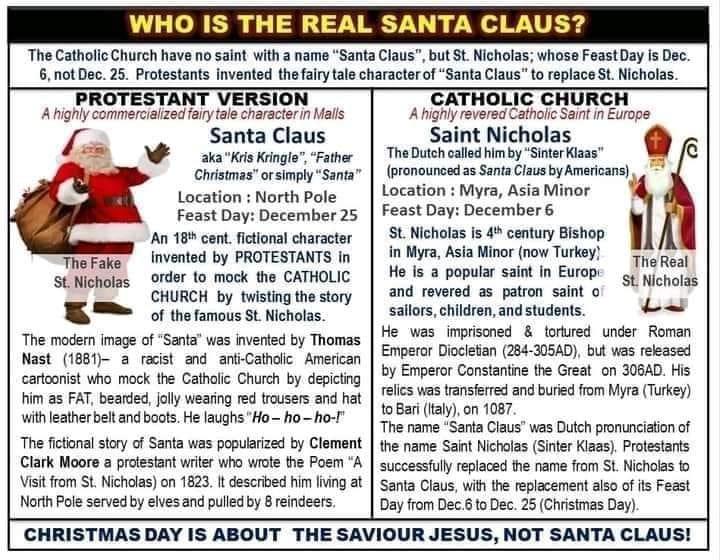HOW SAINT NICHOLAS BECAME SANTA CLAUS
By Stella Marie Lacson

Many people think that Santa Claus is St. Nicholas “in disguise”, and some even ask on “Why he is called “Santa” when he is not a woman?”. Who really is this FAT and white-bearded man named “Santa Claus”?
FROM “ST. NICHOLAS” TO “SINTER KLAAS” FINALLY BECAME “SANTA CLAUS”

Catholics should know that the two figures (Santa Claus & St. Nicholas) have nothing in common except the name. Actually, it was the Dutch immigrants who came to America and established the colony of New Amsterdam that started the idea of “Santa Claus”. At first, their children enjoyed the traditional “Visit of St. Nicholas” on December 5, for the Dutch had kept this ancient Catholic custom even after the Protestant Reformation. Later on, when England also founded the colony of New York in the same territory, the kindly figure of “Sinter Klaas” (which is pronounced like Santa Claus) soon aroused the desire among the English children of having such a heavenly visitor come to their own homes, too.
The English settlers were glad and willing to comply with the anxious wish of their children. However, the figure of a Catholic saint and bishop was not acceptable in their eyes, especially since many of them were Protestants to whom a “bishop” was repugnant.
It was the start that the devotion to St. Nicholas was distorted by the Dutch Protestants, who wanted to erase this “Catholic” tradition. For instance, St. Nicholas was rendered “Sinter Klaas” and later became “Santa Claus”. They also stripped him of his Bishop’s regalia and made him a more nordic looking “Father Christmas” with a fairy red suit and hat.
FEAST DAY MOVED FROM DECEMBER 6 TO DECEMBER 25
Protestants do not celebrate the feasts of Saints according to the ancient Catholic calendar. They later solved the dilemma by transferring the visit of the mysterious man whom the Dutch called “Santa Claus” from eve of December 5 to Christmas day (Dec.25), and by introducing a radical change in the figure itself (i.e fat bearded man, wearing red suit). It was not merely a “disguise” but the ancient Catholic saint was completely replaced by an entirely different fairy tale character. Some clever-minded protestants had invented this substitution in the 19th century (e.g. Thomas Nast and Clement Clark Moore).
During the Middle Ages, often on the evening before St. Nicholas Feast Day of December 5, children were bestowed gifts in his honour. But, since Protestants opposed the veneration of Saints, they changed it to December 25 (Christmas Day). This would in turn became a rival of the Birth of our Lord Jesus Christ. Thus, instead of celebrating Jesus Christ’s birth, children shifted their focus to the fake St. Nicholas who protestants call “Santa Claus”.
PROTESTANT’S SANTA CLAUS WAS FIGURED FROM THE PAGAN GOD “THOR”
Behind the name “Santa Claus” which no longer stands the traditional figure of the Catholic bishop named St. Nicholas, but the Pagan god “Thor” (after whom Thursday is named). To show the origin of the modern Santa Claus tale let us give some details about this god “Thor” from ancient Germanic mythology: ![]()
Thor was the god of the peasants and the common people. He was represented as an elderly man, jovial and friendly, of heavy build, with a long white beard. His element was the fire, his color red. The rumble and roar of thunder were said to be caused by the rolling of his chariot, for he alone among the gods never rode on horseback but drove in a chariot drawn by two white goats (called Cracker and Gnasher). He was fighting the giants of ice and snow, and thus became the Yulegod. He was said to live in the “Northland” where he had his palace among icebergs. By our pagan forefathers he was considered as the cheerful and friendly god, never harming the humans but rather helping and protecting them. The fireplace in every home was especially sacred to him, and he was said to come down through the chimney into his element, the fire (see H.A. Guerber, Myths of Northern Lands , vol.I, p.61ff.,1895).
Here, then, is the true origin of Protestant’s “Santa Claus.” It certainly was a stroke of genius that produced such a charming and attractive figure for our children from the withered pages of pagan mythology. With the Christian Saint, however, whose name he still bears, this Santa Claus has really nothing to do. To be historically correct we would rather have to call him “Father Thor”, “Santa Thor” or some such name.
SANTA LIVING IN NORTH POLE RIDING A SLEIGH PULLED BY 8 REINDEERS
The fictional story that Santa is living in North Pole was invented by a Protestant professor and writer named Clement Clark Moore on 1823 when he wrote the Poem “A Visit from St. Nicholas”. Santa was described here as a big man riding a sleigh pulled by 8 reindeers namely : Dasher, Dancer, Prancer, Vixen, Comet, Cupid, Dunder, and Blixen. It eventually became 9 reindeers when “Rudolp” was added due to the popularity of the song “Rudolph the Red-Nose Reindeer”. Santa laughs with a loud sound “Ho – ho – ho!”.
Again, this fairy tale description of Protestant’s version of Santa Claus was taken from the Pagan god named “Thor”, not from the Christian Saint.
SANTA AS FAT BEARDED MAN WEARING A RED SUIT
The modern figure of Santa Claus was invented on 1881 by an American cartoonist and caricaturist named Thomas Nast. He was popularly known as a racist and anti-Catholic Protestant who mocked the Catholic Church by creating a bearded fat man he called as “Santa Claus”. That image of Santa became the model of many Christmas advertisements and promos in malls and televisions. Unfortunately, the young and innocent children thought that Santa Claus is a real person.
THE REAL SANTA CLAUS
The real Santa Claus lived a long time ago in a place called Myra, Asia Minor (now Turkey). His name was Nicholas. His parents died when he was just a teenager, and left him a lot of money which made him a rich young man. He went to live with his uncle who was then a Catholic priest.
Nicholas had been known as a generous person and had continued helping people. He always tried to help secretly. Years passed and he was chosen to be a bishop in Myra. Bishops look after their people as shepherds look after their sheep. And that is what Nicholas did When there wasn’t any food, he found wheat; so no one went hungry. He always helped people in trouble. All his life Nicholas showed people how to love God and care each other.
After Nicholas died, they told stories of the good and kind things he had done. Sailors took these stories about Nicholas everywhere they went. Some of the stories were about his special care for children—helping and protecting them when danger threatened. And so more and more people learned about the good and kind Nicholas. They wanted to be like him. He is an example of how we should live. And that is why he became a saint. Everyone loved St. Nicholas, specially in Europe. In fact, he is the Patron Saint in Amsterdam and Moscow. This is the true story of the real Santa Claus – who happened to be St. Nicholas.
TO ALL CATHOLIC PARENTS :
Please do tell your children the true story of the real St. Nicholas, not the protestant version of Santa Claus. Because the two figures are entirely different. Considering the historical background, it might even seem better not to tell the children at all that “Santa Claus” is another name of St. Nicholas.
Generally, children do like fairytales, and Santa Claus is one of the most charming of them. Catholic parents might use it without harm, provided they apply some safeguards to avoid an undue overstressing of the Santa Claus figure. Perhaps the following suggestions might help: ![]()
![]() Keep the Santa tale in its simple, appealing form and shun the corruptions introduced by commercial managers, like Santason, Mrs. Santa Claus, and similar repulsive features.
Keep the Santa tale in its simple, appealing form and shun the corruptions introduced by commercial managers, like Santason, Mrs. Santa Claus, and similar repulsive features.
Never allow the figure of Santa Claus to dominate the child’s mind. The Child Jesus must be the main figure in all his Christmas thinking.
![]() Do not let your children present their wishes to Santa. If you want them to write down what they desire, let them write to the Child Jesus according to the old Catholic custom.
Do not let your children present their wishes to Santa. If you want them to write down what they desire, let them write to the Child Jesus according to the old Catholic custom.
The above suggestions will also help to lessen the “shock” when the children find out that “there is no Santa.” As one mother did when her little boy came full of doubts and asked her if there really was a Santa Claus. Such a question should alway be answered in truth, no matter how small the child is.
There are various ways of doing it. However, by following the general idea, parents will have no trouble in setting their children straight about the Santa tale when the right moment comes. The descriptions of great disappointment and psychological conflicts we often read about apply only to families where the parents have misled their own children by allowing Santa to take the central place instead of Christ, whose birthday is the only reason for the whole feast.

REMEMBER: CHRISTMAS IS ALL ABOUT OUR SAVIOUR JESUS, NOT SANTA CLAUS.

